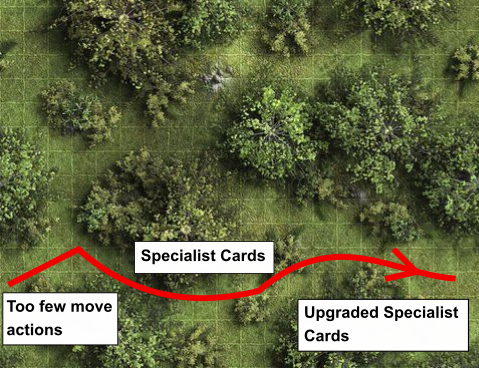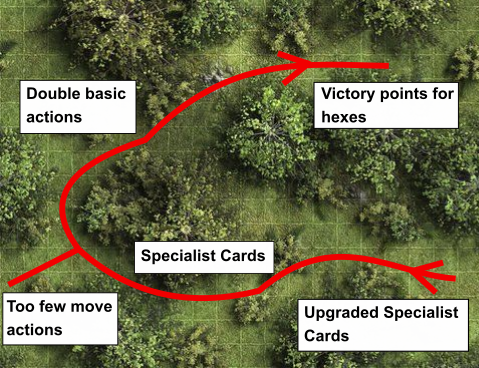
Today we’re going to talk about playtesting: a process which, for designers, is like being lost in a dark and scary wood. You can only find the exit and finish your game with the guidance of your playtesters. Between them, your playtesters know of many different paths to many different exits, so a single project can yield multiple games (my blog is a case in point.)
One must, however, take care in the woods. As soon as an individual playtester becomes invested in your project, they become a less trustworthy guide. They will want to see their great idea from their first playtest pursued to completion, and become blind to other possible paths through the wood. Don’t get me wrong: invested playtesters are essential to the process, but you only want them in about 10% of your playtests. This is also why you should stick to observing rather than playing your game, and never playtest by yourself (in our analogy this is equivalent to blindfolding yourself and wandering into a den of hungry wolves.)
The Specialist Cards
When I started work on Dawn of Gnome I wanted the basic actions to be of equal value. Playtesters soon pointed out this wasn’t the case: the “move” action was prerequisite to attacking and introducing new pieces to the board. A lack of move actions was leading to clunky action loops and frustrated playtesters.
To solve this problem I created a set of “specialist” cards, so called because they linked each action to a specific resource. With more abundant actions the flow of the game improved – so much, in fact, that I combined them with a set of “upgraded specialist” cards. The upgraded specialist cards also rewarded players with victory points for controlling specific hexes.

Death of the Specialists
Playtesters still had too little control over their action loops, so I tried doubling, from three to six, the number of basic action cards they had in their opening hands. This was effective but had the side-effect of removing the need for the specialist cards. Jim and Gregory, my guides for this part of the journey, also had the following feedback on the game:
“It’s obvious which cards I should use for their actions and which for scoring points, can this be a more interesting choice?”
“I STILL want to be rewarded for this huge empire I’ve built.”
I realised I could address all these points by re-introducing the victory-points-for-hexes feature of the upgraded specialist cards. This time, however, it would be included on every card, theoretically giving players more choice in how they score points. Testing this out is my next job. It could be Gnome’s big break or a complete flop – either way I’ll have explored another part of the wood.

Eurosceptic
One thing’s for sure: Gnome is finding its identity. With the new feature it’s become a game in which cards influence the victory point value of hexes – sounds a lot like a eurogame to me. Without the specialist cards, however, I have fewer opportunities to communicate a theme. I had considered a High Fantasy theme in which the specialist cards were “temples” and the resources “elements”. Like with many eurogames, a light touch may be more appropriate.
If that’s not enough, check out this event I’m organising and this campaign I’m helping out with. If you have any thoughts on playtesting you’d like to share, please leave a comment.
Picture credit: Pauline Neilson https://www.pinterest.co.uk/pin/513903007476107276/?lp=true

2 thoughts on “Diary #34 – Into the Woods”